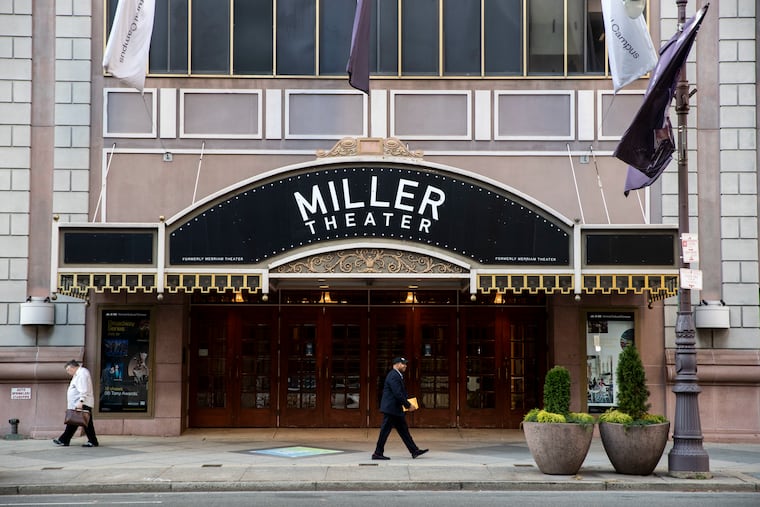Miller Theater on Broad Street is getting a $30 million makeover
The theater previously known as the Merriam is Philadelphia’s great unsung Broadway tryout playhouse.

The Marx Brothers quipped their way across this stage in a three-week run of Animal Crackers in 1928. Yiddish theater bloomed here for decades. In 1963, a chance encounter in the lobby sparked the artistic powerhouse of Kenny Gamble and Leon Huff.
It has endured any number of fires, bankruptcies, dormant stretches, and a spell or two as a burlesque house.
Today, the Broad Street venue known as the Miller Theater can boast a storied history and high demand. And though it has its charms, the 104-year-old hall is longer on the shabby than the chic.
“We have this fantastic artifact right in the middle of town that offers so much,” says architect Richard Maimon, “but it needs so much.”
Maimon and others are having a go at addressing those needs. Now owned by the Philadelphia Orchestra and Kimmel Center, Inc, the theater previously known as the Merriam was renamed the Miller after receiving a gift, announced in March, from health-care executive Alan B. Miller and his family.
Leaders have begun developing a renovation plan that weighs needs against the budget and the amount of time that might be necessary to close the theater to complete the work.
Those needs are major, and some won’t be addressed as part of the current project, the lion’s share of which is being paid for with the Miller gift. There are no current plans, for instance, for a new, more historically accurate Broad Street facade. The existing one, a hodgepodge of new and old elements, is the legacy of a 1980s renovation.
Likewise, updates to the backstage areas and rigging systems are not proposed right now.
But the current project — estimated to cost $30 million — promises to improve the visitor experience. When it’s completed, patrons will likely no longer have to walk through office spaces to reach certain seats, a quirk that leaves unsuspecting visitors wondering what they’ve signed up for.
“We want Philadelphia to have a theater that’s equal to any in the country,” said Miller, 85, a founding member of the Kimmel Center board, in a recent interview. “I’ve gone to the theater many times. I grew up in New York. And we want this theater to be on that level.”
First, though, planners must keep the water from coming in.
“The big theme is addressing the deferred maintenance of the building,” says Maimon, a partner with KieranTimberlake, the Philadelphia architecture firm overseeing the work. He cites leaks in the roof, parapet, and around windows in the masonry walls, whose consequences can be seen in the flaking plaster in several areas of the auditorium. Bathrooms and other amenities haven’t kept pace with modern audience expectations.
The Miller doesn’t grab the same kind of attention as its neighbors — the sleek efficiency of the two main halls at the Kimmel Center on the south or the crystal-and-red-velvet opulence of the Academy of Music just north.
What this middle child theater does offer, though, is a size, unusual in the city, that’s ideal for certain kinds of shows. Smaller than the Academy or Verizon Hall, three times the size of the Perelman, the Miller feels intimate while offering enough ticket income to be profitable.
And: “Not a column in sight,” says Kimmel Center/Philadelphia Orchestra facilities and operations chief Ross S. Richards, referring to the fact that there are no internal columns to block views of the stage (as there are in the Academy of Music).
To help enhance the audience experience, all the seats will be replaced, and the theater will be made ADA compliant (about 100 seats will be lost in the process, leaving about 1,600). Lobby areas will be added and enlarged on three levels.
Renovation planning is expected to continue in 2023, construction to commence in 2024, with completion in 2025.
The work will proceed with an eye toward keeping the extant historic fabric. Most of the building has undergone extensive change, noted a 2017/2019 report by John Milner Architects, which documents the theater’s performance history — not only the Marx Brothers, but also an astonishing roster of actors, singers, and other artists who often tried out shows on Broad Street before opening on Broadway.
“There are two areas that can be categorized as having high integrity: the theater and the marble staircase in the lobby,” says the Milner report. “Most of the other areas have been renovated to support the current educational use of the building; the original finishes have been removed, or they are utilitarian areas with less significant features that are not character-defining.”
But the character that remains is impressively grand.
The shapely marble staircase is the central focal point of the lobby, a relic of the last Horticultural Hall that once occupied the site (two previous Horticultural Halls were destroyed by fire). It will remain. The auditorium itself features murals and some lavish architectural details. The originals will be preserved and cleaned.
Along with previous renovations, the name on the front of the theater has evolved: the Samuel S. Shubert Memorial Theatre, Wilner’s Shubert, the Shubert again, and the Merriam Theater.
Miller’s gift puts the Miller name on the building in perpetuity, an orchestra spokesperson said. Philadelphia Orchestra and Kimmel Center president and CEO Matías Tarnopolsky would neither specify the amount of the gift, nor the amount raised for the project so far.
Kimmel officials in 2016 floated naming rights for the Merriam at between $20 million and $35 million for a deal lasting between 10 and 20 years.
The man whose gift set the renovation in motion has repeatedly declined to say how much his gift was. But he offers that it was motivated in part by that certain feeling the theatrical experience imparts on visitors.
It “makes your life worthwhile,” says Miller. “You walk out of a theater — it’s like nothing else.”